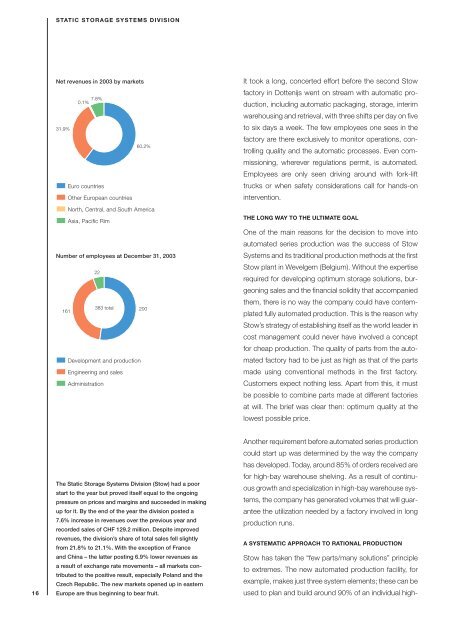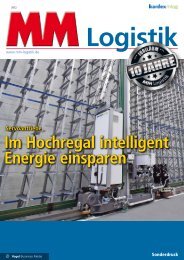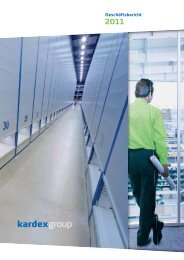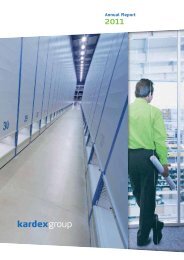You also want an ePaper? Increase the reach of your titles
YUMPU automatically turns print PDFs into web optimized ePapers that Google loves.
16<br />
STATIC STORAGE SYSTEMS DIVISION<br />
Net revenues in <strong>2003</strong> by markets<br />
31.9%<br />
7.8%<br />
0.1%<br />
Euro countries<br />
Other European countries<br />
North, Central, and South America<br />
Asia, Pacific Rim<br />
60.2%<br />
Number of employees at December 31, <strong>2003</strong><br />
161<br />
22<br />
Development and production<br />
Engineering and sales<br />
Administration<br />
383 total<br />
200<br />
The Static Storage Systems Division (Stow) had a poor<br />
start to the year but proved itself equal to the ongoing<br />
pressure on prices and margins and succeeded in making<br />
up for it. By the end of the year the division posted a<br />
7.6% increase in revenues over the previous year and<br />
recorded sales of CHF 129.2 million. Despite improved<br />
revenues, the division’s share of total sales fell slightly<br />
from 21.8% to 21.1%. With the exception of France<br />
and China – the latter posting 6.9% lower revenues as<br />
a result of exchange rate movements – all markets contributed<br />
to the positive result, especially Poland and the<br />
Czech Republic. The new markets opened up in eastern<br />
Europe are thus beginning to bear fruit.<br />
It took a long, concerted effort before the second Stow<br />
factory in Dottenijs went on stream with automatic production,<br />
including automatic packaging, storage, interim<br />
warehousing and retrieval, with three shifts per day on five<br />
to six days a week. The few employees one sees in the<br />
factory are there exclusively to monitor operations, controlling<br />
quality and the automatic processes. Even commissioning,<br />
wherever regulations permit, is automated.<br />
Employees are only seen driving around with fork-lift<br />
trucks or when safety considerations call for hands-on<br />
intervention.<br />
THE LONG WAY TO THE ULTIMATE GOAL<br />
One of the main reasons for the decision to move into<br />
automated series production was the success of Stow<br />
Systems and its traditional production methods at the first<br />
Stow plant in Wevelgem (Belgium). Without the expertise<br />
required for developing optimum storage solutions, burgeoning<br />
sales and the financial solidity that accompanied<br />
them, there is no way the company could have contemplated<br />
fully automated production. This is the reason why<br />
Stow’s strategy of establishing itself as the world leader in<br />
cost management could never have involved a concept<br />
for cheap production. The quality of parts from the automated<br />
factory had to be just as high as that of the parts<br />
made using conventional methods in the first factory.<br />
Customers expect nothing less. Apart from this, it must<br />
be possible to combine parts made at different factories<br />
at will. The brief was clear then: optimum quality at the<br />
lowest possible price.<br />
Another requirement before automated series production<br />
could start up was determined by the way the company<br />
has developed. Today, around 85% of orders received are<br />
for high-bay warehouse shelving. As a result of continuous<br />
growth and specialization in high-bay warehouse systems,<br />
the company has generated volumes that will guarantee<br />
the utilization needed by a factory involved in long<br />
production runs.<br />
A SYSTEMATIC APPROACH TO RATIONAL PRODUCTION<br />
Stow has taken the “few parts/many solutions” principle<br />
to extremes. The new automated production facility, for<br />
example, makes just three system elements; these can be<br />
used to plan and build around 90% of an individual high-









